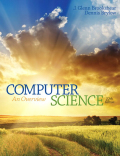
EBK COMPUTER SCIENCE: AN OVERVIEW
12th Edition
ISBN: 8220102744196
Author: BRYLOW
Publisher: PEARSON
expand_more
expand_more
format_list_bulleted
Concept explainers
Question
Chapter 7, Problem 38CRP
Program Plan Intro
Class diagrams:
Class diagrams not only show associations between different classes, but also reveal multiplicities of these associations. Classes are shown by rectangles. Here, relationships of classes are shown by lines.
Expert Solution & Answer
Want to see the full answer?
Check out a sample textbook solution
Students have asked these similar questions
Please answer JAVA OOP problem below:
Assume you have three data definition classes, Person, Student and Faculty. The Student and Faculty classes extend Person. Given the code snippet below, in Java, complete the method determinePersonTypeCount to print out how many Student and Faculty objects exist within the Person array. You may assume that each object within the Person[] is either referencing a Student or Faculty object.
public static void determinePersonTypeCount(Person[] people){
// Place your code here
}
Please answer JAVA OOP question below:
Consider the following relationship diagram between the Game and VideoGame data defintion classes.
Game has a constructor that takes in two parameters, title (String) and cost (double). The VideoGame constructor has an additional parameter, genre (String). In Java, efficiently write the constructors needed within the Game class and VideoGame classes.
Hint: Remember to think about the appropriate validation
In a shopping cart, there are various items, which can either belong to the category of household items or electronic items. The following UML diagram illustrates the relationship between items, household items, and electronic items.
//Implementation Class
public class ShoppingCart{
public static void main(String[] args){
final int MAX_ITEM = 50;
Item cart = new Item[MAX_ITEM];
addItem(cart); // populate the item array
printItem(cart);
}
}
Considering that all the data definition classes and the implementation class are complete, which of the following Object-Oriented Programming (OOP) concepts do you need to use in the above context?
i) Polymorphism
ii) Method Overloading
iii) Method Overriding
iv) Dynamic Binding
v) Abstract Class
Explain, using course terminology, how you would use any of the above concepts to model the given scenario.
Chapter 7 Solutions
EBK COMPUTER SCIENCE: AN OVERVIEW
Ch. 7.1 - Prob. 1QECh. 7.1 - Prob. 2QECh. 7.1 - Prob. 3QECh. 7.1 - Identify two contexts in which the field of...Ch. 7.2 - Prob. 1QECh. 7.2 - Prob. 2QECh. 7.2 - What is the role of a software requirements...Ch. 7.3 - Prob. 1QECh. 7.3 - Prob. 2QECh. 7.3 - Prob. 3QE
Ch. 7.3 - What potential problems do you suspect could arise...Ch. 7.4 - Prob. 1QECh. 7.4 - Prob. 2QECh. 7.4 - Prob. 3QECh. 7.4 - Prob. 4QECh. 7.4 - Prob. 5QECh. 7.4 - What is the difference between a traditional...Ch. 7.4 - Prob. 8QECh. 7.5 - Prob. 1QECh. 7.5 - Prob. 2QECh. 7.5 - Prob. 3QECh. 7.5 - Prob. 4QECh. 7.5 - Prob. 6QECh. 7.6 - Prob. 1QECh. 7.6 - Prob. 2QECh. 7.6 - Prob. 3QECh. 7.6 - Prob. 4QECh. 7.6 - Prob. 5QECh. 7.6 - Prob. 6QECh. 7.7 - Prob. 1QECh. 7.7 - Prob. 2QECh. 7.7 - Prob. 3QECh. 7.8 - Prob. 1QECh. 7.8 - Prob. 2QECh. 7.8 - Prob. 3QECh. 7.8 - Prob. 4QECh. 7.9 - Prob. 1QECh. 7.9 - Prob. 2QECh. 7.9 - Prob. 3QECh. 7 - Give an example of how efforts in the development...Ch. 7 - Prob. 2CRPCh. 7 - Explain how the lack of metrics for measuring...Ch. 7 - Would you expect that a metric for measuring the...Ch. 7 - Prob. 5CRPCh. 7 - Prob. 6CRPCh. 7 - Prob. 7CRPCh. 7 - Prob. 8CRPCh. 7 - Prob. 9CRPCh. 7 - Prob. 10CRPCh. 7 - Prob. 11CRPCh. 7 - Prob. 13CRPCh. 7 - Prob. 14CRPCh. 7 - Prob. 15CRPCh. 7 - Prob. 16CRPCh. 7 - Prob. 17CRPCh. 7 - Prob. 18CRPCh. 7 - Prob. 20CRPCh. 7 - Prob. 21CRPCh. 7 - Prob. 22CRPCh. 7 - Prob. 23CRPCh. 7 - Prob. 24CRPCh. 7 - Contrast the information represented in a class...Ch. 7 - What is the difference between a one-to-many...Ch. 7 - Prob. 27CRPCh. 7 - Prob. 28CRPCh. 7 - Prob. 29CRPCh. 7 - Prob. 30CRPCh. 7 - Prob. 31CRPCh. 7 - Prob. 32CRPCh. 7 - Prob. 33CRPCh. 7 - Prob. 34CRPCh. 7 - Extend your solution to the previous problem to...Ch. 7 - Prob. 38CRPCh. 7 - Prob. 39CRPCh. 7 - Identify some design patterns in fields other than...Ch. 7 - Prob. 41CRPCh. 7 - Prob. 42CRPCh. 7 - Prob. 43CRPCh. 7 - Prob. 44CRPCh. 7 - Prob. 45CRPCh. 7 - Prob. 46CRPCh. 7 - How does open-source development differ from beta...Ch. 7 - Prob. 48CRPCh. 7 - Prob. 49CRPCh. 7 - Prob. 50CRPCh. 7 - Prob. 51CRPCh. 7 - Prob. 52CRPCh. 7 - In what ways can a software developer be...Ch. 7 - Prob. 1SICh. 7 - Prob. 2SICh. 7 - Prob. 3SICh. 7 - Prob. 4SICh. 7 - Prob. 5SICh. 7 - What happens if technology begins to advance so...Ch. 7 - Is the computer revolution contributing to, or...Ch. 7 - Prob. 8SICh. 7 - If you had a time machine, in which period of...Ch. 7 - Prob. 10SI
Knowledge Booster
Learn more about
Need a deep-dive on the concept behind this application? Look no further. Learn more about this topic, computer-science and related others by exploring similar questions and additional content below.Similar questions
- Answer this JAVA OOP question below: An Employee has a name, employee ID, and department. An Employee object must be created with all its attributes. The UML diagram is provided below: - name: String - employeeId: String - department: String + Employee(name: String, employeeId: String, department: String) + setName(name: String): void + setEmployeeId(employeeId: String): void + setDepartment(department: String): void + getName(): String + getEmployeeId(): String + getDepartment(): String + toString(): String A faculty is an Employee with an additional field String field: rank public class TestImplementation{ public static void main(String[] args){ Employee[] allEmployee = new Employee[100]; // create an employee object with name Tom Evan, employee ID 001 and department IST and store it in allEmployee // create a faculty object with name Adam Scott, employee ID 002, department IST and rank Professor and store it in allEmployee } }arrow_forwardPlease answer this JAVA OOP question that is given below: An Employee has a name, employee ID, and department. An Employee object must be created with all its attributes. The UML diagram is provided below: - name: String - employeeId: String - department: String + Employee(name: String, employeeId: String, department: String) + setName(name: String): void + setEmployeeId(employeeId: String): void + setDepartment(department: String): void + getName(): String + getEmployeeId(): String + getDepartment(): String + toString(): String A faculty is an Employee with an additional field String field: rank Assuming the Employee class is fully implemented, define a Professor class in Java with the following: A toString() method that includes both the inherited attributes and the specializationarrow_forwardPlease answer JAVA OOP question below: An Employee has a name, employee ID, and department. An Employee object must be created with all its attributes. The UML diagram is provided below: - name: String - employeeId: String - department: String + Employee(name: String, employeeId: String, department: String) + setName(name: String): void + setEmployeeId(employeeId: String): void + setDepartment(department: String): void + getName(): String + getEmployeeId(): String + getDepartment(): String + toString(): String A faculty is an Employee with an additional field String field: rank Assuming the Employee class is fully implemented, define a Professor class in Java with the following: Instance variable(s) A Constructorarrow_forward
- Develop a C++ program that execute the operation as stated by TM for addition of two binary numbers (see attached image). Your code should receive two binary numbers and output the resulting sum (also in binary). Make sure your code mimics the TM operations (dealing with the binary numbers as a string of characters 1 and 0, and following the logic to increase the first number and decreasing the second one. Try your TM for the following examples: 1101 and 101, resulting 10010; and 1101 and 11, resulting 10000.arrow_forwardI need to define and discuss the uses of one monitoring or troubleshooting tool in Windows Server 2019. thank youarrow_forwardI would likr toget help with the following concepts: - Windows Server features - Windows Server versus Windows 10 used as a client-server networkarrow_forward
arrow_back_ios
SEE MORE QUESTIONS
arrow_forward_ios
Recommended textbooks for you
- Np Ms Office 365/Excel 2016 I NtermedComputer ScienceISBN:9781337508841Author:CareyPublisher:Cengage
 C++ for Engineers and ScientistsComputer ScienceISBN:9781133187844Author:Bronson, Gary J.Publisher:Course Technology Ptr
C++ for Engineers and ScientistsComputer ScienceISBN:9781133187844Author:Bronson, Gary J.Publisher:Course Technology Ptr Database Systems: Design, Implementation, & Manag...Computer ScienceISBN:9781305627482Author:Carlos Coronel, Steven MorrisPublisher:Cengage Learning
Database Systems: Design, Implementation, & Manag...Computer ScienceISBN:9781305627482Author:Carlos Coronel, Steven MorrisPublisher:Cengage Learning  Database Systems: Design, Implementation, & Manag...Computer ScienceISBN:9781285196145Author:Steven, Steven Morris, Carlos Coronel, Carlos, Coronel, Carlos; Morris, Carlos Coronel and Steven Morris, Carlos Coronel; Steven Morris, Steven Morris; Carlos CoronelPublisher:Cengage Learning
Database Systems: Design, Implementation, & Manag...Computer ScienceISBN:9781285196145Author:Steven, Steven Morris, Carlos Coronel, Carlos, Coronel, Carlos; Morris, Carlos Coronel and Steven Morris, Carlos Coronel; Steven Morris, Steven Morris; Carlos CoronelPublisher:Cengage Learning Operations Research : Applications and AlgorithmsComputer ScienceISBN:9780534380588Author:Wayne L. WinstonPublisher:Brooks Cole
Operations Research : Applications and AlgorithmsComputer ScienceISBN:9780534380588Author:Wayne L. WinstonPublisher:Brooks Cole Management Of Information SecurityComputer ScienceISBN:9781337405713Author:WHITMAN, Michael.Publisher:Cengage Learning,
Management Of Information SecurityComputer ScienceISBN:9781337405713Author:WHITMAN, Michael.Publisher:Cengage Learning,

Np Ms Office 365/Excel 2016 I Ntermed
Computer Science
ISBN:9781337508841
Author:Carey
Publisher:Cengage

C++ for Engineers and Scientists
Computer Science
ISBN:9781133187844
Author:Bronson, Gary J.
Publisher:Course Technology Ptr

Database Systems: Design, Implementation, & Manag...
Computer Science
ISBN:9781305627482
Author:Carlos Coronel, Steven Morris
Publisher:Cengage Learning

Database Systems: Design, Implementation, & Manag...
Computer Science
ISBN:9781285196145
Author:Steven, Steven Morris, Carlos Coronel, Carlos, Coronel, Carlos; Morris, Carlos Coronel and Steven Morris, Carlos Coronel; Steven Morris, Steven Morris; Carlos Coronel
Publisher:Cengage Learning

Operations Research : Applications and Algorithms
Computer Science
ISBN:9780534380588
Author:Wayne L. Winston
Publisher:Brooks Cole

Management Of Information Security
Computer Science
ISBN:9781337405713
Author:WHITMAN, Michael.
Publisher:Cengage Learning,